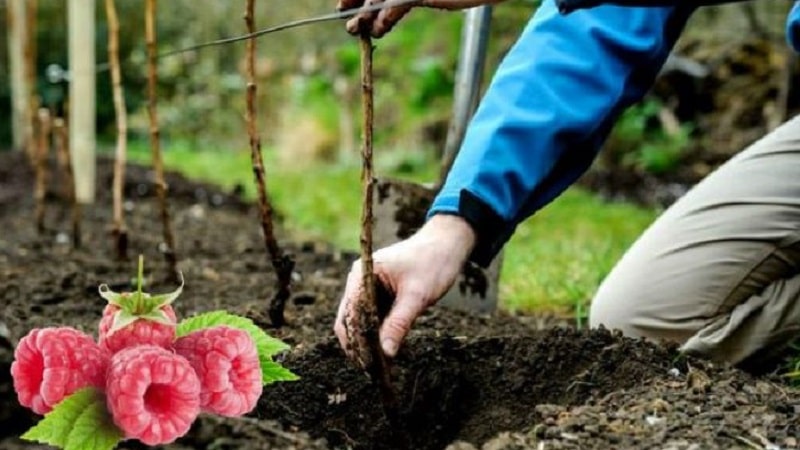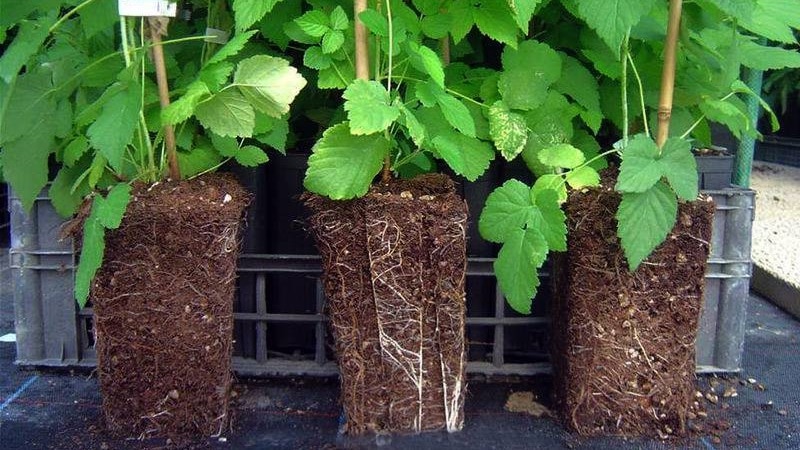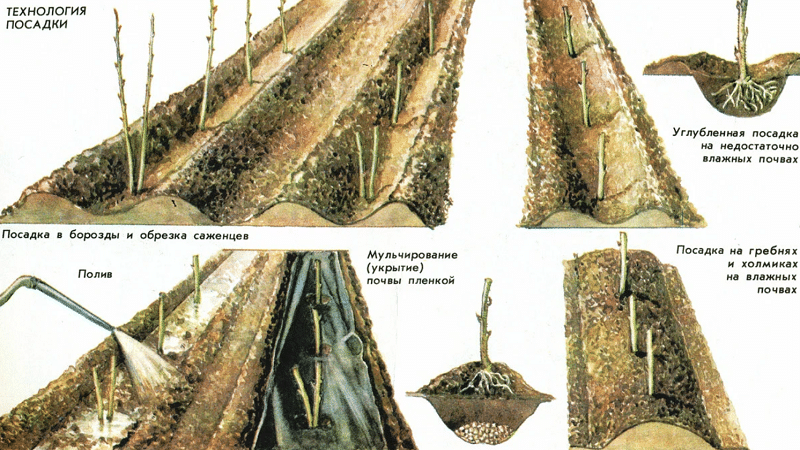Instructions for planting raspberries for beginner gardeners
Proper planting of raspberry bushes and choosing a site with residual lighting and fertile soil is the key to successful cultivation of the crop and a rich harvest in the future. Gardeners practice several methods of planting raspberries, regardless of their variety. Each of these methods can be used in different regions of the country, subject to deadlines taking into account the climate. In this article we will tell you how to plant raspberries correctly, how to determine the planting pattern, where it is better to plant bushes and how to care for them.
Basic rules for planting raspberries
Raspberries are a fairly unpretentious crop, capable of growing and bearing fruit in the same place for several years in a row. Before planting, it is important to correctly select and prepare a lighted area with fertile soil to provide the plant with nutrients. Some varieties do well in partial shade, but the planting site should be protected from drafts. It is for this reason that bushes are recommended to be planted along walls or fences, as well as under trees.

Raspberries prefer loose and permeable soil rich in humus. Loam is best suited. It is also possible to grow raspberries on sandy loam with excellent fertility, but the gardener will have to regularly apply fertilizers and water the tree trunk.
It is not recommended to plant bushes on slopes or hills - the crop will not receive enough moisture. It is worth noting that acidic and clay soils are the most unsuitable for growing raspberries.On such soils, the plant suffers from nutrient deficiency, develops poorly and does not bear fruit.
Special attention should be paid to the peculiarities of planting remontant raspberries. This type of crop is especially popular among gardeners, because the harvest can be harvested until the end of September.
On South remontant raspberries planted in the second ten days of March, in the middle regions - in the last days of March, in the Urals and Siberia - in July.
The site is located at a distance of 0.5-1 m from walls and fences. Drained loam is best. Before planting, the soil is loosened, watered, and fertilized with humus or peat. The optimal distance between seedlings is 30-60 cm. When planting using the bush method, two seedlings are placed in each hole.
When is the best time to plant
Raspberries are planted throughout the warm period (spring-early autumn), but, as practice shows, the bushes take root best in the spring. This happens for several reasons:
- Sap flow begins with the arrival of warm weather. Thanks to this, the immune system is strengthened, the plant recovers faster after such traumatic procedures as pruning, planting, grafting.
- In spring, weather conditions are the most favorable: there is no sweltering heat and high humidity.
- Most insects and pathogens of viral and bacterial diseases are inactive.
Reference. Raspberries in summer can be planted in early June and in the second half of August, in the fall - in early September.
Features of planting at different times of the year
Raspberry planting dates vary depending on the climate zone and shift within a range of 2-3 weeks from the northern to the southern regions. When planting, it is recommended to focus on a number of indicators:
- air temperature - +18...+26 °C;
- air humidity up to 40%;
- Daylight hours: from 12 hours.
For those who prefer to navigate by the lunar calendar, we advise you to choose the most favorable period for planting - from the new moon to the full moon.
Favorable days in 2022:
- March - 2-17;
- April - 3-16;
- May - 1-15, 30, 31;
- June - 1-13, 29, 30;
- July - 1-12, 29-31;
- August - 1-10, 28-31;
- September - 1-6, 9, 27-30.
The unfavorable period is the full moon and new moon, as well as days when the Moon is in the barren sign of Aquarius.

Unfavorable days in 2022:
- March - 1, 18, 27-28;
- April - 1, 23-25, 30;
- May - 16, 21, 22, 30;
- June - 14, 17, 18, 29;
- July - 13, 14, 15, 28;
- August - 11, 12, 26, 27;
- September - 7, 8, 10, 12.
Nuances for different regions
In the southern regions of Russia, the climate is mild, so raspberries are planted in the fall. The seedlings will take root safely in the new place before the cold weather, and in the spring they quickly gain green mass. If desired, spring planting is done in the spring (in March - early April).
In the north and in the middle zone, the crop is planted in April. The high humidity characteristic of this time of year favors the survival of seedlings in a new place.
In Siberia and the Urals, planting occurs at the end of April - early May.
What is needed for planting
Stock up on the following materials before planting raspberries:
- bayonet-spatula for digging up an area and forming recesses;
- a rake for collecting plant debris and leveling the tree trunk circle;
- a 10-15 liter bucket for watering;
- wooden stakes and rope for gartering seedlings;
- mulch (straw, hay, sawdust, peat);
- organic and mineral fertilizers;
- sand for loosening the soil;
- gravel to strengthen the bottom of a hole or trench.
Soil preparation
Breathable loam with low acidity in the range of 5.5-6.5 pH is ideal for raspberries. Soil preparation is done in the fall: they plow to a depth of 30-40 cm, remove weeds and plant debris, and feed with wood ash (200 g per 1 m2). In the fall, it is recommended to sow lupine, rye, flax, clover, and oats on the site, and in the spring, mow and embed it in the soil. Green manure acts as a source of nutrients and does not require large financial investments; in addition, it is an environmentally friendly source of nutrition for raspberries.
Sandy loam or sandy soil is fertilized with organic compounds - 5-8 kg of humus or manure is added per 1 m2. Together with organic matter, gardeners use potassium (30-40 g per 1 m2) or superphosphate (50-60 g per 1 m2).
Selection and preparation of planting material
The quality of planting material affects the amount of harvest. When choosing seedlings, pay attention to the root system - it should be developed, without signs of infection or traces of rot. The rhizome of a healthy raspberry seedling looks fibrous and is 15 cm long.

We advise beginners to buy seedlings with a closed root system. They are sold in pots or tight bags of soil. Carefully inspect the material before planting, cut off dry, damaged and diseased roots, put it in a clay mash and leave it to dry in the open air.
How to plant raspberries correctly - instructions for different methods
There are several ways to plant raspberries. We will tell you about the most popular ones - those that do not cause any special problems for novice gardeners and guarantee excellent results.
Bush method
The bush or hole method of planting raspberries involves the formation of a bush with 6-12 developed stems.The seedlings are placed around the support, keeping a gap between them of 50-70 cm. In this case, the row spacing is 1.5-1.8 m. The distance can be adjusted upward depending on raspberry varieties. Some varieties require extensive space due to the strong growth of shoots.
2 weeks before planting, holes are dug in the area with a depth and width of 30-40 cm. 10 liters of humus are placed in each, after mixing it with the soil.
The following is also added to the nutritional mixture:
- 30 g of potassium sulfate;
- 50 g superphosphate;
- 200 g wood ash;
- 100 g bone meal.
About 10 cm of clean soil is poured on top and a seedling is placed. The roots are carefully straightened, the root collar is left on the surface. The tree trunk circle is mulched with straw, dry leaves or peat.

Tape
The tape method is considered more labor-intensive, however, many gardeners prefer it. Trenches are dug in the prepared area, which provides better access to the raspberries and allows for unhindered harvesting. In addition, the plantings look more aesthetically pleasing.
The distance between bushes is 30-50 cm, between rows - 1.8-2 m. The depth of the trenches is 40 cm. A nutritious soil mixture is placed at the bottom: 3 kg of manure, 30 g of superphosphate, 20 g of potassium salt per 1 m2. 10 cm of clean soil is poured on top.
Advice. Place the trenches from south to north. So the eastern part will be perfectly illuminated by the sun in the morning, and the western part in the afternoon.
Algorithm for planting raspberries using the tape method:
- The rhizome should fit completely into the recess.
- The soil is watered with clean, settled water.
- The seedling is placed vertically and tied to a support.
- The roots are covered with soil and compacted slightly.
- The tree trunk circle is watered and humidity is controlled for 2-3 days after planting.

Trench
The trench method of planting raspberries is a variation of the strip method. Its difference lies in the creation of a nutrient cushion, which is placed at the bottom of the recess. Thus, the bushes receive uninterrupted access to nutrients.
In the prepared area, dig a trench of any length, 60-70 cm deep, 40-50 cm wide. Heavy clay soil is loosened with sand. 10 cm of gravel is placed at the bottom, and plant residues are placed on top as fertilizer. The first layer is branches, the second is fallen leaves, hay and some greenery. To ensure uniform “ripening” of the layers, each of them is covered with a layer of sawdust or fertile soil. Remember that the plant base should consist exclusively of healthy trees and shrubs. In addition, it must be spilled with plenty of water.
A soil mixture of turf, mineral and organic additives is laid on top. The edges of the trenches are fenced with slate dug to a depth of 0.5 m to prevent roots from spreading across the area.
In tires
Planting raspberries in car tires is an interesting planting method. The sides retain moisture and liquid fertilizers, and the raspberry tree has a neat appearance.
The tires are deepened halfway into the prepared hole, or left on the surface of the earth. The space of the tire is filled with a soil mixture of turf, humus and minerals, seedlings are placed in the center, watered and mulched with straw.
Places up to three bushes in one car tire, and up to 5 seedlings in a tractor tire.

In a container without a bottom
This method of planting raspberries is suitable for small areas.The seedlings are placed in plastic or metal containers without a bottom, 50x50 cm in size. Any bucket that is placed in a prepared hole will do. The space is filled with fertile soil mixed with rotted manure. This method will allow you to save space, plant several varieties of raspberries and restrain the growth of the root system.
Neighborhood with other cultures
Next to raspberries you can plant apple, plum, pear, rowan, currant and blackberry, barberry. Dill attracts pollinators, and basil, chamomile, parsley, tansy, marigold, and calendula repel insect pests. Sorrel planted around the perimeter of the raspberry tree restrains the growth of adventitious roots, so that the raspberries do not spread throughout the entire area.
It is undesirable to place raspberries next to the following crops:
- cherry inhibits growth and reduces yield;
- strawberries, potatoes and nightshade crops often become a source of diseases;
- broom inhibits the growth of adventitious roots.
Care after landing
Caring for raspberries after planting is simple, the main thing is to follow a number of rules:
- After planting, the seedlings are shortened to 25 cm if the seller did not do this. The procedure preserves the plant’s strength, inhibits the growth of green mass, and strengthens the root system.
- The tree trunk circle is covered with mulch: mown grass, straw, peat, sawdust. The optimal layer height is no more than 7 cm. This allows you to retain moisture inside the soil, provides access to nutrients to the horse system, inhibits the growth of weeds, and protects against the spread of insect pests.
- Remontant raspberries love moisture more than other varieties, so the gardener must provide constant and abundant watering.To make it easier to care for the raspberry tree on the site, it is recommended to organize a drip irrigation system, and in the heat, arrange sprinkling.
- If all the conditions for high-quality fertilizer were met when planting seedlings, there is no need to fertilize in the next 2-3 years. After this period, organic matter (ash, humus) and potassium-phosphorus additives are added to the soil.
- After harvesting, the bushes are trimmed, and sanitary pruning is performed in the spring.
- In regions with unfavorable weather conditions, bushes are pressed against each other, tilted to the ground and tied to protect them from frost. They are covered with tarpaulin or agrofibre on top, and also insulated with spruce branches.
- Raspberries planted by bush method are tied in the form of a fan so that the shoots do not break under the weight of the berries. Two pegs are driven between the bushes, and shoots of neighboring plants are tied to them at different heights.
- Raspberries planted using the ribbon method are tied to trellises: wire is pulled between the supports in several rows and the branches are secured at a slight angle.
- Spring treatment against insects is carried out after the shoots have stretched 15 cm. Irrigation is carried out using a solution of Karbofos or colloidal sulfur. In addition, folk remedies are used: infusion of garlic, tansy, onion peel.

Advice from experienced gardeners
Experienced gardeners advise:
- Observe the dosage when applying fertilizers: raspberries do not like excess potassium, nitrogen, and phosphorus.
- Before wintering, add 3 g of zinc sulfate and 5 g of manganese sulfate per 1 m2 to the soil in order to increase the protective forces of plants.
- In autumn, trim off shoots that have bear fruit at the root, as well as green growth that will not have time to ripen before the cold weather.To be on the safe side, leave up to 20% of fruit-bearing branches to get a reserve for the development of the bush in the spring.
- In early autumn, reduce watering to a minimum to stimulate lignification of shoots and better wintering.
- Carry out autumn spraying with 2% Bordeaux to increase winter hardiness.
- Promptly remove plant debris from the area - a source of fungal waterlogging and a wintering site for insect pests.
- After the snow melts, treat the raspberries with a 5% solution of Bordeaux mixture to repel insects.
Conclusion
Growing raspberries in the garden is a pleasant and not too labor-intensive task. Knowing the basic rules for planting bushes allows you to annually harvest an excellent harvest of aromatic berries. The best time to plant seedlings is spring or autumn. The timing depends on the region where the crop is grown. In the south of the country, bushes are planted mainly in early autumn, in the middle regions - in April, in areas with more severe weather conditions - in late April-early May.
The most common methods of planting shrubs are bush, strip, and trench. Some gardeners like to experiment and plant bushes in car tires and containers without a bottom. Raspberry tree care involves timely application of fertilizers, sufficient watering, sanitary pruning in the spring and shaping after harvesting.